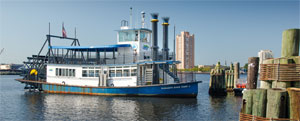Only the occasional muffled sound emanating from the BAE Systems shipyard across the Elizabeth River from Norfolk’s Waterside Marketplace and the low drone of Elizabeth River Ferry II approaching from Portsmouth cut the quiet of a September morning washing over Hampton Roads.
“One thing about Hampton Roads is you can’t escape the tunnels,” Tom Holden, public affairs officer for Hampton Roads Transit (HRT), said while waiting for the ferry at the Waterside Ferry Dock. “All the crossings are very busy.”
Bridge and tunnel commuters the world over grit their teeth and strike out for work each morning in grudging acceptance of their circumstance. At Hampton Roads, the waterways separating Norfolk, Portsmouth, Newport News, Hampton and Chesapeake are particularly frustrating for vehicular transit.
The Hampton Roads ferry service between Norfolk and Portsmouth is a pleasant way to avoid the tolls and chaos of midtown and downtown tunnels and the mayhem of the Berkley Bridge. In addition to the regularly scheduled route, connecting a triangle of landings at Waterside in Norfolk and High Street and North Landing in Portsmouth, the three 150-passenger ferries in the fleet operate whenever there is a baseball game or big event at Harbor Park in Norfolk.
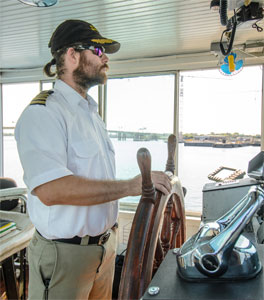 |
|
Capt. Brian Dutton at the controls during the river crossing between Norfolk and Portsmouth. |
“It’s one of the easiest ways to save cash, instead of driving and dealing with the tunnels,” said commuter Brendon Ferguson. “And it saves time, too,” chimed in fellow passenger Matthew Harridon. Ferguson and Harridon, both wielding large portfolio cases, utilize the ferry to commute between Norfolk and the TCC Visual Arts Center in Portsmouth.
Elizabeth River Ferry II, built in 1986, is powered by two 350-hp 6V71 Detroit Diesels with Twin Disc gears turning 2.5-inch shafts and 32-inch four-blade bronze propellers. The actual vessel is 59 feet by 23 feet with another 14 feet added for the paddlewheel, a purely cosmetic touch. The draft is a meager 3.8 feet.
Capt. Brian Dutton, 13 years with HRT, cites wind as his biggest challenge. “It’s a flat-bottom, shallow-draft boat,” he said.
Elizabeth River Ferry III has two Tier-3 Volvo 400-hp D13 engines. James C. Echols is powered by two 400-hp 6V71 Detroit Diesels.
Hampton Roads Transit has initiated the bidding process for two new ferries with similar specifications but with the stipulation that both will be powered by Volvo or equivalent engines. Mark Stemple, director of technical services for HRT, explained that the new vessels will be steel-hulled with aluminum from the deck up as a hedge against maintenance.
Expanding the fleet from three to five 150-passenger boats is testament to the frustration of bridge and tunnel commuting, or perhaps the recent initiation of tolls on the tunnels.
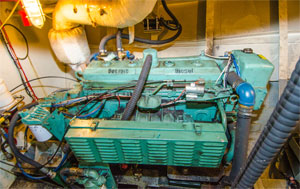 |
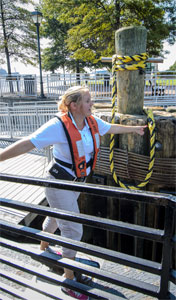 |
|
|
One of Elizabeth River Ferry II’s dual 350-hp 6V71 Detroit Diesel main engines. |
Deck hand Renee Toller ties up a line at North Landing in Portsmouth. |
|
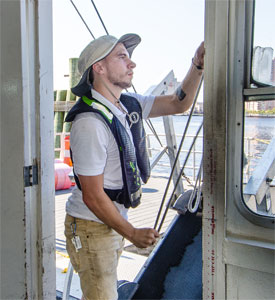 |
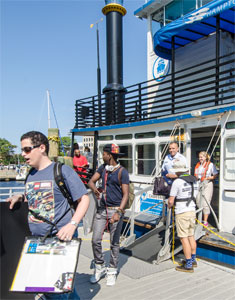 |
|
|
Deck hand Matthew Woodby lowers the gangway to get ready for passenger disembarkation. |
Commuters Brendon Ferguson, far left, and Matthew Harridon, center, exit the ferry. |
|
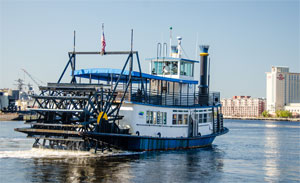 |
||
|
The Elizabeth River Ferry II features a cosmetic paddlewheel. |
||

